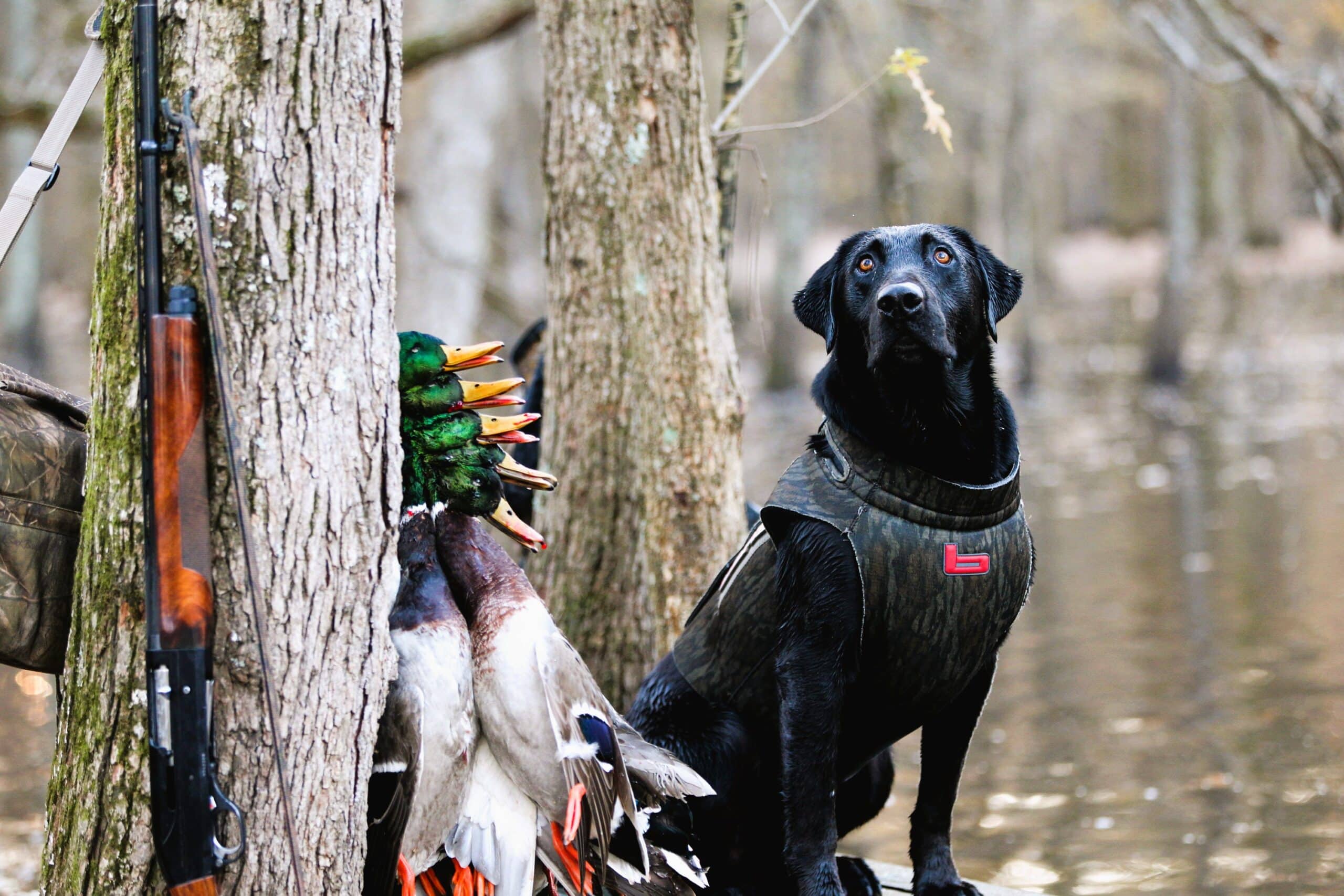Water Scarce in Some Public Hunting Areas, but Some Opportunities Exist
It’s become a standard refrain for the opening of Arkansas’s waterfowl season in recent years that conditions are dry around the state, though at least there may be more moisture than this time last season. In spite of water scarcity, though, waterfowl hunters should see some ducks around The Natural State when the season opens Saturday at 30 minutes before sunrise.

By Jim Harris
Managing Editor Arkansas Wildlife Magazine

“I expect it to be fairly similar to a normal Arkansas opening weekend,” Brett Leach, the Arkansas Game and Fish Commission’s waterfowl program coordinator, said. “Driving around to areas, the habitat all looks pretty good. I was at Ed Gordon (Point Remove WMA on Tuesday) and their moist soil units, they all looked top-notch and they’re getting water out in the areas. Obviously it’s been a dry fall, so there’s not a whole lot of water for the (greentree reservoirs) right now, they just started putting in boards this week to hold water.”
The complete list of AGFC’s waterfowl-managed WMAs, with greentree reservoirs and moist soil units, is listed below. The Arkansas waterfowl season is 60 days, with the first segment of three running nine days, Nov. 18-26. There is a 13-day break before the second segment starts Dec. 10. Hunting begins 30 minutes before sunrise until sunset. Hunting in WMAs runs until noon.
A few public areas such as Ed Gordon Point Remove WMA, as Leach mentioned, are getting decent water on the ground with pumping from Point Remove Creek. However, other public areas like Steve N. Wilson Raft Creek Bottoms WMA, which has become one of the most popular hunting areas in Arkansas, are struggling to get enough water to accommodate even a few hunters for opening weekend.
Hunting at Raft Creek Bottoms is by draw permit only on the weekends, and permits as allocated only for the number of available hunting areas — only a handful spots in Raft Creek Bottoms had water to hunt this weekend. While permits also are required there on Tuesdays and Thursdays, they can be picked up at the visitors kiosk, but accessible hunting likely will still be limited next week. Most hunters will have to access it by walking in.
Following drought conditions for several weeks in late summer and early fall, Arkansas received a statewide dousing of major rainfall the weekend before last; however, Leach said, a lot of that water seems to have dried up from what he’s seen driving around the state and checking on the WMAs.
“The private clubs who have access to water will have pumped it into their fields or woods, and they’ll have ducks. The rain we had provided some water, but talking to a lot of the guys across the state, it sounds like it’s going to be oxbows that people will be hunting and competing for limited water,” Leach said.
Leach has been scouting conditions around the state in the runup to waterfowl season, including a trip nearly two weeks ago in the Jonesboro area, where he saw many pintails and greenwing teal. This week he was in the Dale Bumpers White River National Wildlife Refuge and the Stuttgart area, where he spotted more mallards arriving.
“All the sheet water (from the big rains) I saw really has been drying up,” he said. “But there have been quite a few birds around while I’ve been driving around. I’ve seen a lot of pintails, and last week I saw more mallards coming into the state. There are quite a few (greater white-fronted geese) around that (Stuttgart) area and definitely a lot more snows are starting to show up now, too. Still the majority of geese are specks flying around … we had quite a few flocks flying over us at the White River.”
Leach, who joined the AGFC last January, is a native of Wisconsin and has checked in with friends around the country for their outlook on waterfowl in their areas, to get an idea of what might be in the offing in coming weeks here.
“I haven’t heard much north of us,” he said. “I’ve got some buddies hunting in Missouri who have been doing pretty well the last few days. North Dakota, they really are starting to freeze up there now. They had 10 inches of snow earlier this year.”
Coverage of food sources north of Arkansas will do more to push more birds this way. Last year’s big movement of birds didn’t happen until around Christmastime, when the midwest from just above the Arkansas state line was blanketed by snow and ice. Leach was hopeful of weather forecasts this week calling for a cold front just before opening day that might help some birds along their migration paths.
“We’ll start seeing a few more ducks coming in later this week,” he said. “They’re calling for some north winds.”
WRICE Permits Go Fast
The opening weekend of waterfowl season attracted a larger than usual number of applications for private land hunting permits to open the year with the Arkansas Waterfowl Rice Incentive Conservation Enhancement program. The process drew more than 400 applications for available rice field hunts.
The program this year has enrolled landowners with 78 fields with leftover rice stubble, but limited water availability with some reduced the number of huntable fields for the first weekend to around 40.
While opening day opportunities are spoken for, hunters interested in a field for the Nov. 25-26 weekend can begin applying for a WRICE permit at 3 p.m. Thursday. The application period ends at midnight Sunday, and winners are contacted on Monday with information for hunting their field. (Permits that are required for WMAs such as Steve N. Wilson Raft Creek Bottoms WMA and Sheffield Nelson Dagmar WMA also are available for application during this same period.)
The cost to apply for a permit is $5. Winners of permits may bring three guests on their hunts (the permit winner must be present if the group is hunting), and the hunting parties may hunt both weekend days from 30 minutes before sunrise until sunset.
The format continues throughout the season. Those seeking a WRICE permit should plan to apply the week before the available hunt. Each application period starts at 3p.m. Thursday, nine days before that selection’s hunt.
The three segments of the Arkansas waterfowl season are Nov. 18-26, Dec. 9-23 and Dec. 27-Jan. 31. Youths may also apply for an available WRICE permitted field on the scheduled special youth hunts of Dec. 2 and Feb. 3.
To apply for a WRICE permit, visit the newly updated agency website, agfc.com, click on the “Buy Your 2023 Hunting License” tag and then the “Special Permit Hunts” tag. More information is available at https://www.agfc.com/education/arkansas-waterfowl-rice-program-wrice/.
Information on applying for permits required for certain WMAs (Steve N. Wilson Raft Creek Bottoms, Cypress Bayou WMA Red Cut Slough, Sheffield Nelson Dagmar WMA Conway George Tract youth blinds, and Freddie Black Choctaw Island WMA West Unit youth hunts) can be found at https://www.agfc.com/hunting/waterfowl/special-waterfowl-permit-hunts/. Permits will be limited, if not unavailable, if there is no water on the ground to allow hunting.
How to Join the WRICE Program
The WRICE program, now in its sixth year, has been funded through a Voluntary Public Access grant through the Natural Resources Conservation Service, in which landowners are paid for maintaining acres for habitat suitable for migratory waterfowl, and in turn allowing public access on their private property. The program was popular with hunters in the Western United States. Luke Naylor, formerly the waterfowl program coordinator and now chief of the Wildlife Management Division, worked with the NCRS to bring VPA funds to Arkansas after the program had been funded by the AGFC for its first two years.
Landowners agree to postpone post-harvest tillage of their rice fields and do no disking. They can roll their fields, burn them or leave the rice stubble standing. Then they hold water in the fields during the season, striving for 4-18 inches of water across the field. Most fields have either pits or skid blinds, and the blinds have been brushed. This information is available on the agency’s WRICE webpage and also made available to winners of the weekly permits.
Scouting of fields is permitted before the hunt as long as the permit holders stay on the state or county roads in the vicinity of the fields, or if they use the designated parking areas.
Nonresidents Get 30-Day Fix
The Arkansas Game and Fish Commission unanimously approved on Oct. 31 a new 30-day permit for nonresident duck hunters who wish to hunt on AGFC-managed wildlife management areas.
According to the current Arkansas Code of Regulations nonresidents may only duck hunt on WMAs during the first nine days of regular duck season; Dec. 27-Jan. 5; and Jan. 21-31. To hunt, they must have a valid 5-day Nonresident WMA Waterfowl Hunting Permit or the new 30-day Nonresident WMA Waterfowl Hunting Permit. The creation of the new permit satisfied an issue with the reduced number of days a nonresident could hunt on WMAs. Without it, a nonresident hunter would have had to purchase seven of the 5-day permits at $40 each to be able to hunt the full allotment of 30 days allowed each season, with two of those permits not being able to be used to their full extent.
The new 30-day Nonresident WMA Waterfowl Permit is available for $200 and is valid for all dates nonresidents may hunt waterfowl on Arkansas WMAs.
Another change to the AGFC Code of Regulations was an increase to the yearly limit of the agency’s new Resident Natural State Lifetime Combination License and Permit available to Arkansas residents aged 10 and under. Initially, 500 of these licenses were to be sold per fiscal year, but that cap has now been raised to 1,000 licenses available for purchase each fiscal year. The license, which gives its recipients the privileges associated with a Resident Combination Sportsman’s License, Arkansas state duck stamp and Arkansas trout stamp for life, is available for $500, a $500 savings from the standard Lifetime Hunting and Fishing Sportsman’s Permit that offers the same privileges.
According to AGFC Deputy Director Spencer Griffith, the eligibility of a youth to qualify for this license is backdated to Aug. 1, 2023.
“Anyone who was under 10 as of Aug. 1 can get this license this year,” Griffith said. “We already have more than 350 of these licenses sold, and we expect to see many more purchased as Christmas presents for youths this year.”


